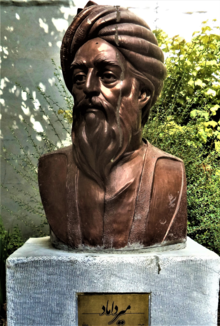Mir Damad

Mir Damad (Persian: ميرداماد) (d. 1631 or 1632), known also as Mir Mohammad Baqer Esterabadi, or Asterabadi, was a Twelver Shia Iranian philosopher in the Neoplatonizing Islamic Peripatetic traditions of Avicenna. He also was a Suhrawardi, a scholar of the traditional Islamic sciences, and foremost figure (together with his student Mulla Sadra) of the cultural renaissance of Iran undertaken under the Safavid dynasty. He was also the central founder of the School of Isfahan, noted by his students and admirers as the Third Teacher (mu'alim al-thalith) after Aristotle and al-Farabi.
Children
Son: Seyed Ali Naghi Astarabadi
grandson:
Sayyid Mahdi bin Sayyid Ali Naqi
Male result:
Sayyid Hassan bin Al-Sayyid Mahdi
The man has not been seen:
Seyyed Ali Naqi Ibn Al-Seyyed Al-Musa (father of three sons: Seyyed Kamal Hassanzadeh Hafshjani, Seyyed Musa Hassanzadeh Hafshjani, Seyyed Mohammad Hafshjani and three daughters: Seyyed Ala Ala Begum Hassanzadeh Esther Shamsabadi, who had a special reputation): Mirza Nasrollah Karimian, Mirza Assadollah Karimian, Mirza Ali Karimian, Mirza Mehdi Karimian (father of musician Kaveh Karimian), Mirza Reza Karimian, Mirza Jalal Karimian, Mirza Hassan (father of Dr. Milad Karimian), Mirza Taghi Karimian, Seyedeh Tajzadeh Astarabad, Seyedeh Aghabazadeh , Hassanzadeh family]
His daughter is the wife of Sayyid Ahmad ibn Zayn al-Abidin Alavi.
Philosophy[]
His major contribution to Islamic philosophy was his novel formulation regarding gradations of time and the emanations of the separate categories of time as descending divine hypostases. He resolved the controversy of the createdness or uncreatedness of the world in time by proposing the notion of huduth-e-dahri (atemporal origination) as an explanation grounded in Avicennan and Suhrawardian categories, whilst transcending them. In brief, excepting God, he argued all things, including the earth and all heavenly bodies, share in both eternal and temporal origination. He influenced the revival of al-falsafa al-yamani (), a philosophy based on revelation and sayings of prophets rather than the rationalism of the Greeks, and he is widely recognized as the founder of the School of Isfahan, which embraced a theosophical outlook known as hikmat-i ilahi (divine wisdom).
Mir Damad’s many treatises on Islamic philosophy include (Calendars of Faith, a treasure on creation and divine knowledge), the (Book of the Divine Embers of Fiery Kindling), wherein he lays out his concept of atemporal origination, and Sirat al-Mustaqim. He also wrote poetry under the pseudonym of Ishraq (Illumination). He also wrote a couple of books on mathematics, but with secondary importance.
Among his many other students besides Mulla Sadra were Seyyed Ahmad-ibn-Reyn-al-A’bedin Alavi, Mohammad ibn Alireza ibn Agajanii, and .
Mir Damad's philosophical prose is often accounted as being among the most dense and obtusely difficult of styles to understand, deliberately employing as well as coining convoluted philosophical terminology and neologisms that require systematic unpacking and detailed commentary. He was called Mir Damad (Groom of the King) because he married Shah Abbas's daughter and hence his fame was based on that event.
Architecture[]
Mir Damad was also the architect of the Masjide Shah (Shah Mosque) in Isfahan which employed highly advance mathematical calculations which required the knowledge of the speed of sound at that time. The geometry of the dome is as such that all sound dissipated from the base will echo in hundreds of carefully calculated and masterly executed interior corners of the dome which will ultimately collide in the center of the dome. The geometrical analysis of the dome is of absolute sophistication and the design of the dome is a magnificent piece of art and furthermore the construction of such dome in the 17th century to a precision where all sound waves must travel and collide in an imaginary point above.
Works[]
Among his 134[1] works known:
- (Calendars of Faith)
- (Book of the Divine Embers of Fiery Kindling)
- (Book of Spiritual Attractions)
- Sirat al-Mustaqim (The Straight Path)
See also[]
- Islamic scholars
- List of Iranian scholars
- Sayyid Husayn Ahlati
References[]
Further reading[]
- Ian Richard Netton (2013). Encyclopedia of Islamic Civilization and Religion. Routledge, Oxon, UK. ISBN 1135179670.
- Encyclopædia Iranica: Mir Damad.
- Webster Encyclopedia of Religion.
- Rizvi, Sajjad H. (2006). "Between Time and Eternity: Mīr Dāmād on God's Creative Agency". Journal of Islamic Studies. Oxford University Press. 17 (2): 158–176. doi:10.1093/jis/etl003.
External links[]
- Iranian philosophers
- Iranian inventors
- Islamic philosophers
- 17th-century Iranian people
- 1630s deaths
- 17th-century people of Safavid Iran
- People from Gorgan
- Safavid theologians